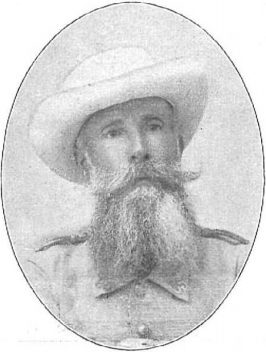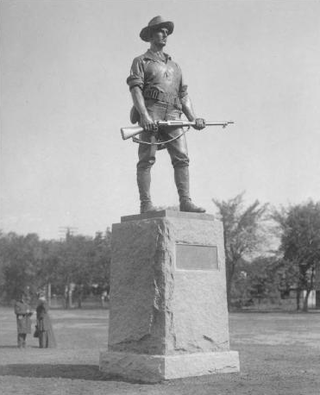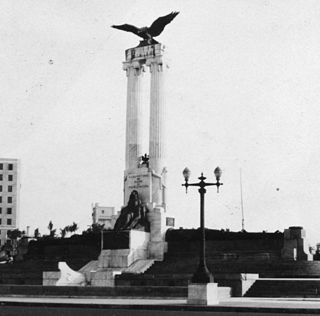
Maine was a United States Navy ship that sank in Havana Harbor on February 15, 1898, contributing to the outbreak of the Spanish–American War in April. U.S. newspapers, engaging in yellow journalism to boost circulation, claimed that the Spanish were responsible for the ship's destruction. The phrase, "Remember the Maine! To hell with Spain!" became a rallying cry for action. Although the Maine explosion was not a direct cause, it served as a catalyst that accelerated the events leading up to the war.

The Battle of Manila Bay, also known as the Battle of Cavite, took place on 1 May 1898, during the Spanish–American War. The American Asiatic Squadron under Commodore George Dewey engaged and destroyed the Spanish Pacific Squadron under Contraalmirante Patricio Montojo. The battle took place in Manila Bay in the Philippines, and was the first major engagement of the Spanish–American War. The battle was one of the most decisive naval battles in history and marked the end of the Spanish colonial period in Philippine history.

The Battle of El Caney was fought on July 1, 1898, during the Spanish-American War. 600 Spanish soldiers held for twelve hours, until they ran out of ammunition, against Henry W. Lawton's 5th US Division, made up of 6,899 men. This action temporarily delayed the American advance on the San Juan Hills, as had been requested of General William Rufus Shafter. Nevertheless, American forces advanced on San Juan Hill the same day. Though encountering spirited resistance similar to El Caney, the Americans were ultimately victorious, culminating in the capitulation of the Spanish garrison.

The Puerto Rico campaign was the American military sea and land operation on the island of Puerto Rico during the Spanish–American War. The offensive began on May 12, 1898, when the United States Navy attacked the capital, San Juan. Though the damage inflicted on the city was minimal, the Americans were able to establish a blockade in the city's harbor, San Juan Bay. On June 22, the cruiser Isabel II and the destroyer Terror delivered a Spanish counterattack, but were unable to break the blockade and Terror was damaged.

Joaquín Vara de Rey y Rubio was a Spanish military officer. He is best known for leading the tenacious defense of El Caney against a massively superior American force during the Spanish–American War.

Hamilton Ward Jr. was an American lawyer and politician.

El Cementerio de Cristóbal Colón, also called La Necrópolis de Cristóbal Colón, was founded in 1876 in the Vedado neighbourhood of Havana, Cuba to replace the Espada Cemetery in the Barrio de San Lázaro. Named for Christopher Columbus, the cemetery is noted for its many elaborately sculpted memorials. It is estimated the cemetery has more than 500 major mausoleums. Before the Espada Cemetery and the Colon Cemetery were built, interments took place in crypts at the various churches throughout Havana, for example, at the Havana Cathedral or Church Crypts in Havana Vieja.

The Intentona de Yauco of March 24–26, 1897 was the second and final short-lived revolt against Spanish rule in Puerto Rico. It was staged by the pro-independence Revolutionary Committee of Puerto Rico in the southwestern municipality of Yauco, 29 years after the first unsuccessful revolt, known as the Grito de Lares. During the Intentona de Yauco, the current flag of Puerto Rico was flown on the island for the first time.

The Hiker is a bronze statue created by Theo Alice Ruggles Kitson. It commemorates the American soldiers who fought in the Spanish–American War, the Boxer Rebellion, and the Philippine–American War. The first version of it was made for the University of Minnesota in 1906, but at least 50 copies were made, and were erected widely across the United States.

The Hiker is a statue created by Allen George Newman. Like Theo Alice Ruggles Kitson's statue of the same name, it was created to honor the American soldiers who took "long hikes in steaming jungles" during the Boxer Rebellion, the Spanish–American War and the Philippine–American War. Originally displayed in the New York building at the 1907 Jamestown Exposition, the statue was chosen by several camps of the United Spanish War Veterans to be erected as war memorials.

The Cuban Friendship Urn, also known as the Cuban–American Friendship Urn or USS Maine Memorial, is a marble statue in Washington, D.C., listed on the National Register of Historic Places. The monument originally stood in Cuba to honor the American deaths aboard the USS Maine preceding the Spanish–American War in 1898.

The Monument to the Victims of the USS Maine was built in 1925 on the Malecón boulevard at the end of Línea Calle, in the Vedado neighborhood of Havana, Cuba.

The USS Maine Mast Memorial is a memorial honoring those who died aboard the USS Maine (ACR-1) on February 15, 1898, after a mysterious explosion destroyed the ship while at anchor in Havana Harbor. It is located in Arlington National Cemetery in Arlington County, Virginia, in the United States. The memorial consists of the main mast of the battleship set atop a circular concrete burial receiving vault designed to resemble a battleship turret. The memorial has occasionally been used to hold the remains of important individuals, such as Lord Lothian and Ignacy Jan Paderewski.

The Spanish–American War Memorial is a memorial in Arlington National Cemetery in Arlington County, Virginia, in the United States that commemorates those American military personnel who died in the Spanish–American War. Constructed by the National Society of the Colonial Dames of America and dedicated on May 21, 1902, the memorial consists of a granite column in the center of a small grass-covered plaza. A granite sphere and bronze eagle with outstretched wings stand atop the shaft. The memorial faces west; to its rear across Lawton Avenue is a flagstone terrace on which are placed four cannon, aimed east.

The Spanish–American War Nurses Memorial is a memorial in Arlington National Cemetery in Arlington County, Virginia, in the United States that commemorates those American nurses who died in the Spanish–American War in 1898. The rough-hewn, grey granite memorial was erected by the Order of Spanish–American War Nurses on May 2, 1905. It stands in the southwestern corner of Section 21, where the first Spanish–American War nurses are buried.

The Rough Riders Memorial is a memorial in Arlington National Cemetery in Arlington County, Virginia, in the United States that commemorates those members of the "Rough Riders" who died in the Spanish–American War in 1898. The grey granite shaft was erected by surviving members of the Rough Riders and their friends and supporters. Although Arlington National Cemetery, a number of secondary sources, and even the bronze plaque on the memorial say the monument was dedicated in 1906 and one source says 1905, contemporary newspaper accounts show the memorial was dedicated on April 12, 1907.

The Battleship Maine Monument is a memorial marker in Davenport Park, Bangor, Maine. It commemorates veterans of the Spanish–American War, and the loss of the USS Maine due to an explosion of unknown cause, which sparked the start of the war. Placed in 1922, it includes the shield and scrolls of the Maine, which were recovered from its wreckage in the harbor of Havana, Cuba. The memorial was listed on the National Register of Historic Places in 1999. Of several memorials to that war and the loss of the Maine, it is the most elaborate in the state.
The Dewey Cannon is an antique Spanish bronze cannon. Currently, it is a Michigan registered historic site located in Three Oaks in the U.S. state of Michigan. Originally emplaced on the island of Corregidor, the cannon was captured by the United States Navy in 1898 after the Battle of Manila Bay. The heavy gun was shipped to the United States as a prize of war and used as a competition trophy in a patriotic fundraising drive. After Three Oaks was declared the winner of the contest, the cannon was awarded to the people of Three Oaks. A park close to the center of the town, Dewey Cannon Park, has been landscaped to provide a setting for the massive trophy.






















